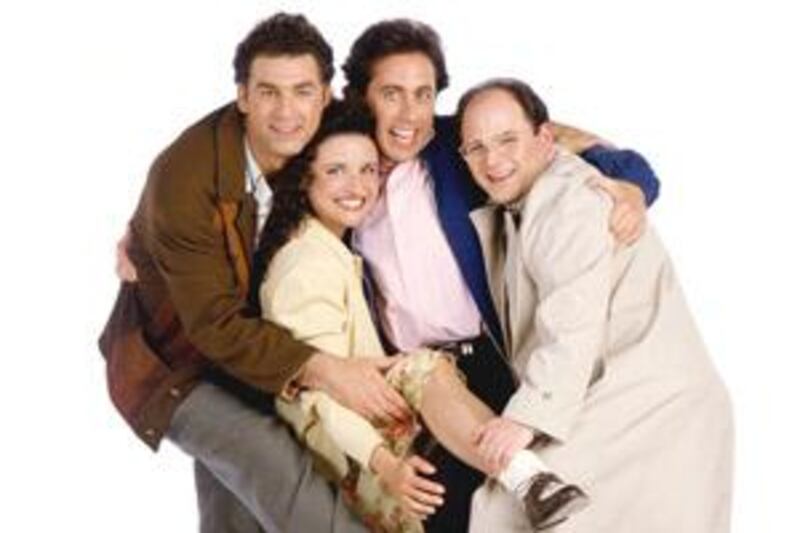Seinfeld is back. That's right. Larry David, the co-creator of the series about nothing, has signed up all four original characters for appearances on the seventh season of his show, Curb Your Enthusiasm, due to start airing in the US from September. "For years it's been the question people ask me every single day, 'When's the Seinfeld reunion?'" he explained at a television conference in California last week.
Except his plans aren't quite for a reunion. Instead, Jerry, George, Elaine and Kramer will individually pop up in different episodes of Curb, all preparing for a comeback special. Only will the season finale bring all four together again. "Viewers won't see the entire show," said David. "But you'll get an idea of what a reunion special could look like, and where the Seinfeld characters are 11 years later."
It's not a moment too soon for fans of the show, often cited as the greatest sitcom ever made. Search for Seinfeld on Facebook and you'll find a group of diehard followers almost half a million strong - and a wall consisting of endless lines from the show, famed for catchphrases such as "yada yada yada" and "no soup for you!". "Block of cheese the size of a car battery!" writes another; one of those lines that will mystify the uninitiated, yet raise a hearty chuckle from the show's cult following.
Seinfeld was a phenomenon all right. In 1998, the final episode was watched by 76 million people in the US, or 58 per cent of all those watching television that night. (An evening overshadowed only partly by the death of Frank Sinatra.) "Say it ain't so," blazed the front of People magazine that week, with the added tagline: "A stunned nation prepares for life without Seinfeld." By the end of the ninth and final season, the star and co-creator Jerry Seinfeld had amassed a fortune of over $250 million (Dh920m). Since then the show has reportedly provided him an income of $60 million (Dh220m) a year. NBC offered $5m(Dh18m) per episode to Seinfeld for a tenth season. He refused.
Strange to think that the show came perilously near failure at the start of its life. When NBC television executives and a test audience were first shown the pilot in 1989, the reaction was chilly. As far as they were concerned, the characters had no redeeming qualities, the material seemed to be about nothing and some were irritated by Seinfeld's stand-up routines being interrupted by acted scenes. Philistines, all.
Happily, a few executives allowed the first season of five episodes to run, which then ran into seasons two and three, though it still bumped along with low ratings. But by 1993 when season four started, it was moved to a slot after Cheers and, bang, off it thundered. So why the great success? Why did such a mundane look at everyday life on the Upper West Side of Manhattan become an international hit? Well, presumably if scriptwriters knew that we wouldn't be plagued with haemorrhage-inducing sitcoms such as Joey and Veronica's Closet. But ask any Seinfeld devotee and they will tell you it's about Seinfeld's very ordinary observations. Take one of his supermarket bits, for example. "Very important, the rubber divider stick - I don't want other people's items fraternising with my items," he once joked. Or his thoughts on dry-cleaning fluid: "It's not a fluid if it's dry."
David and Seinfeld - both previously comedians on the New York stand-up circuit - joked about such trivialities while having dinners together, and the show developed from these "idiotic conversations", as Seinfeld consequently dubbed them. The ordinariness of the show is reflected in the episode titles: The Jacket, The Chinese Restaurant, The Parking Space. Hardly designed to grab you. There are 180 in total, released in 2007 as a bumper box set of 32 DVDs with over 100 hours of bonus material, although constant reruns can be found on television channels across the world at any given point.
Three years after the show finished, Seinfeld went on David Letterman's talk show. "What have I been doing?" he asked mockingly in reply to Letterman's questioning. "Everybody says to me, 'Hey, you don't do the show anymore. What do you do?' I'll tell you what I do - nothing." The other three main cast members - Jason Alexander, Julia Louis-Dreyfus and Michael Richards - have also been successful in achieving little to rival the show's success. Here's hoping they can all conjure up something out of nothing again.
* Sophia Money-Coutts





